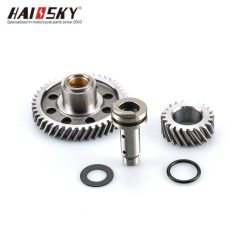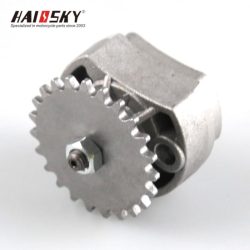OEM Motorcycle Parts
Motorcycle Crankshafts: A Comprehensive Guide for B2B Buyers
When it comes to motorcycle engines, few components are as critical as the crankshaft. This powerhouse part converts the linear motion of pistons into rotational force, driving the motorcycle’s wheels and ensuring smooth operation. For B2B wholesalers, understanding the nuances of motorcycle crankshafts—from types and maintenance to selection criteria—is key to meeting client demands. In this guide, we’ll dive deep into optimizing performance, durability, and value for your inventory.
Types of Motorcycle Crankshafts
Different engine configurations require specialized crankshaft designs. Here’s a breakdown of the most common types:
Single-Cylinder Crankshaft
Found in entry-level bikes and off-road motorcycles, this simple, cost-effective design features a single piston pin. Its rugged construction suits low-to-moderate power outputs, making it ideal for scooters and commuter bikes.
Parallel Twin Crankshaft
Used in modern mid-range motorcycles, this design synchronizes two pistons in a 180° or 360° configuration. It balances power delivery and reduces vibrations, offering a blend of efficiency and performance for urban and touring bikes.
V-Twin Crankshaft
A staple in cruisers and high-torque bikes, the V-twin crankshaft aligns two cylinders in a V-shape. Its staggered power strokes deliver the iconic rumbling exhaust note and robust low-end torque, favored for long-distance rides.
Inline-Four Crankshaft
Designed for high-performance sports bikes, this crankshaft manages four pistons in a linear arrangement. It ensures ultra-smooth power delivery at high RPMs, maximizing speed and acceleration.
Electric Motor Crankshaft (E-Crank)
Emerging in electric motorcycles, this component converts electrical energy into mechanical motion. Though simpler than combustion engine crankshafts, precision engineering is critical to handle instant torque demands.
Specifications and Maintenance Best Practices
To ensure longevity and reliability, crankshafts require adherence to strict maintenance protocols:
Regular Inspections: Check for wear, scoring, or misalignment during routine servicing. Early detection of issues like bent shafts or worn journals prevents catastrophic failures.
Optimal Lubrication: Use manufacturer-recommended oils to minimize friction. Poor lubrication accelerates bearing wear and can lead to overheating.
Balancing: Precision balancing reduces vibrations, protecting adjacent components like camshafts and transmission systems. Dynamic balancing is preferred for high-RPM engines.
Torque Compliance: Always tighten bolts to OEM specifications. Over-tightening can warp the crankshaft, while under-tightening risks loosening under stress.
Load Management: Discourage overloading motorcycles beyond their capacity, as excessive strain shortens crankshaft lifespan.
How to Choose the Right Motorcycle Crankshaft
For wholesalers, selecting the right crankshaft involves balancing technical specs with market demands:
Engine Compatibility
Match crankshafts to engine displacement (e.g., 125cc vs. 1000cc), cylinder count, and firing order. Cross-reference OEM part numbers to avoid misfits.
Material Quality
Forged steel crankshafts dominate the market due to their strength. High-end models may use nitride-treated surfaces or alloy steels for lightweight durability in racing applications.
Application-Specific Design
Touring Bikes: Prioritize smoothness and balance for vibration-free rides.
Off-Road Bikes: Opt for crankshafts with reinforced journals to handle rough terrain shocks.
Performance Bikes: Look for lightweight, high-RPM-capable designs.
Vibration Control
Counterweighted crankshafts are essential for multi-cylinder engines to minimize harmonic vibrations that degrade engine components.
OEM vs. Aftermarket
While OEM parts guarantee compatibility, premium aftermarket crankshafts often offer enhancements like improved balance or materials—ideal for performance-focused buyers.
Crankshaft Replacement: Professional Insights
While crankshaft replacement is typically a job for certified mechanics, B2B clients may seek guidance for their repair networks. Key steps include:
Disassembly: Remove engine covers, pistons, and timing systems to access the crankshaft.
Extraction: Use hydraulic presses or pullers to safely remove the old crankshaft without damaging engine blocks.
Installation: Ensure precise alignment during fitting. Improper installation can cause misalignment, leading to premature wear.
Post-Installation Testing: Conduct compression and leak-down tests to verify engine integrity.
Q&A: Addressing Key Concerns
Q1: What is a crankshaft on a motorcycle?
A1: The crankshaft is the engine’s backbone, converting piston movement into rotational force to propel the motorcycle. It’s integral to power delivery and engine balance.
Q2: What are the symptoms of a bad crankshaft?
A2: Look for excessive vibrations, knocking noises, oil leaks from seals, or sudden power loss. Persistent warning lights (e.g., oil pressure) may also indicate issues.
Q3: How do you confirm a crankshaft is faulty?
A3: A mechanic can perform a visual inspection for scoring or bends. Dial gauges measure runout, while magnetic particle testing detects cracks.
Q4: How much does crankshaft replacement cost?
A4: Costs vary widely:
Aftermarket:
200
–
200–800 (depending on engine size).
OEM:
500
–
500–1,500+.
Labor adds
300
–
300–1,000, influenced by engine complexity.
Final Thoughts
For wholesalers, stocking the right motorcycle crankshafts means understanding technical requirements, market trends, and client needs. By prioritizing quality, compatibility, and durability, businesses can position themselves as trusted partners in the B2B motorcycle parts industry. At Haissky.com, we offer a curated selection of crankshafts tailored to diverse engine types—ensuring your inventory meets the demands of mechanics, retailers, and riders alike.
Looking for reliable crankshaft solutions? Explore Haissky.com’s wholesale catalog today.






